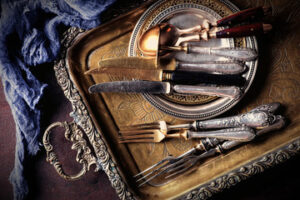Silverware is a set of items made out of silver and is usually used for serving food and drinks. It can be purchased in sets and can be found in several different types, including sterling silver, silver gilt, and Britannia.
 Sterling silver has long been the standard material for fine flatware. In the past, it was often mixed with other metals to increase its hardness and durability. For example, a 7.5% sterling silver and copper alloy is commonly used. Copper is added to make the alloy stronger and more resistant to tarnishing. Many other metals can be used instead of silver. These include platinum, zinc, and manganese.
Sterling silver has long been the standard material for fine flatware. In the past, it was often mixed with other metals to increase its hardness and durability. For example, a 7.5% sterling silver and copper alloy is commonly used. Copper is added to make the alloy stronger and more resistant to tarnishing. Many other metals can be used instead of silver. These include platinum, zinc, and manganese.
Stainless steel silverware has become increasingly popular for many reasons. It’s durable, easy to maintain, and looks great. And it doesn’t cost a fortune. But not all stainless steel flatware is created equal. There are different material grades, including 18/0, 18/8, and 18/10. Each grade contains different metals and percentages of chromium and nickel. When shopping for flatware, you should consider how the pieces are handled. Some stainless steel cutlery is dishwasher safe, while others may need hand washing.
Another consideration is the alloy composition of the metal. Some manufacturers don’t mention the alloy content in their packaging, but it’s important to know what it is so you can choose the best possible product. The 18/10 grade of stainless steel is generally considered the highest material quality. It’s the most durable and the best looking. However, it costs a little more.
Whether you’re looking for something fancy for a special occasion or just a simple tableware for everyday use, sterling silver flatware can be just what you need. These durable pieces are easy to clean and maintain and will never go out of style. They are also a great way to create a beautiful family heirloom.
Some silverware is one of the most popular and most sought-after collectibles. It’s made of a combination of sterling and silver plates. In the late 19th century, there were many silver companies. Some were family related or closely linked. Others were independent makers. As the market became more crowded, some silversmiths were incorporated into a single company. This company eventually became the world’s largest silverware manufacturer.
During this time period, there were many names that silversmiths used. Mergers and family relationships often separated them. Makers of sterling still use the name. The value of silverware depends on the silver’s quality and the price others are willing to pay for it. You can find a good range of prices on online auction sites or get a quote from a reputable antiques dealer or certified appraiser.
Usage in the eighteenth century. The use of silverware in the eighteenth century was a time of great transformation. The kitchen of the day evolved from a crude and unsanitary state to one that was clean, hygienic and highly sophisticated. One of the most dramatic changes to the kitchen occurred in the mid-18th century when forks became popular in Europe. Before this, meals were eaten from a series of wooden plates, cups and trenchers. When the affluent began to acquire wealth, they started using more elaborate tableware.
A fork, also called a coryate, is a long, flat, spoon-like device used to eat food. It has two or three tines. During the late 16th and early 17th centuries, forks were made of wood, horn, shell and other materials. However, a few wealthy families possessed silver spoons.
Common hallmarks on silverware. Silver hallmarks are small, stamped symbols located on the underside of a silver piece. These are an important part of identifying antique silverware. They can give information on the manufacturer and the purity of the metal. Historically, these symbols were used to indicate the quality of the precious metal. Hallmarks were also used as a consumer protection tool. In the UK, these symbols are still used today.
The first documented hallmark was the leopard’s head. This symbol was used by the Goldsmiths’ Company. It was a reference to the guardians of the craft.There were numerous other types of stamps, including the town mark. This indicates the city where the item was made. A full set of these symbols comprises the town mark, a purity mark and a maker’s mark. All three are required to be present on a silver piece.

